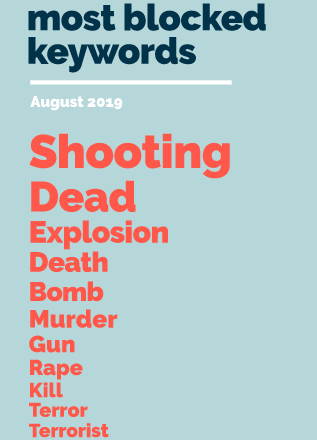US news publishers have lost $2.8 billion to keyword blacklisting in 2019. For UK news and magazine publishers, the loss figure is £170 million.
Ad blocking has cost US approximately $9 billion, almost three times that of keyword blacklisting. This is to bring into your perspective that keyword blacklisting is also causing significant damage to your revenue.
If you think you don’t deal with restricted keywords and hence, you are safe, then this post is for you.
Let’s start by understanding the whats and whys of keyword blacklisting.
What is Keyword Blacklisting?
Keyword blacklisting is a process of blocking content containing one or more blocked keywords. If/When these keywords appear in the content and URL of a publisher’s page, the advertiser’s system blocks them from showing ads.
Ad tech is very strict when it comes to illegal, obscene, and adult content. Some publishers often face problems with AdSense (like account disabling issues) if they fail to adhere to safe practices. This is why publishers avoid putting restricted content on their webpages.
In the same way, to maintain the integrity and safety of their brands, most advertisers don’t want to show their ads on websites showing restricted content.
While on the outside, this seems like a great idea to maintain safety on the internet, publishers have lost a lot of revenue due to this practice.
Why is Keyword Blacklisting a Problem in Ad Tech?
Advertiser side campaigns use the list of blacklisted keywords that stop ads running on a problematic story. While it seems like it benefits publishers by adhering to safe business practices, the number of blacklisted keywords are increasing to as many as 3000 words.
Execution of this brand safety practice causes noticeable issues. Most advertisers take the help of software/programs to detect and block restricted keywords. This program scans the publisher’s webpage and matches restricted words with the content. If one or more blacklisted keywords are found, the webpage is blocked.
For instance, if you, a publisher, write about ‘photoshoot’, then your content can be blocked because of the presence of the word ‘shoot’.
In recent news, Duke and Duchess of Sussex leaving the Royal family was a big story to cover for most news and magazine sites. However, some stories were blocked because of the use of the word ‘sex’ in ‘Sussex’.
In sports coverage, writers use words like ‘attack’, ‘kill’, ‘injury’ quite frequently. And these are blacklisted words that are blocked by the advertiser’s brand safety program.


These topics (sports, recent news) might bring the most traffic to publishers. Likewise, publishers put a lot of time and energy into creating them. In response, publishers would expect to make good money out of these posts via advertising. But, some words, even when used in a neutral tone, are facing the same fate of blocking.
Are There Any Possible Solutions?
The commonly used solution to this problem is avoiding blacklisted keywords and finding synonyms instead.

However, sometimes it is tricky to stop using certain words, especially for news websites—as they are expected to deliver stories with complete transparency. Imagine if a car crash story has a headline with ‘wheelie’ in it. This gives the story a funny tone than using ‘crash’ that makes it serious, as it is supposed to be.
In the same way, content covering ‘nude lipstick’ is banned for its obscene undertone, and using ‘bare lipstick’ doesn’t make sense to readers.
The industry needs a smart solution that doesn’t just block the content by finding unsafe keywords. But a system that understands the context of the word used in a story.
Reach and IBM might have the same solution. They have launched a platform, Mantis, using IBM Watson to design a smart brand safety solution.
From a brand perspective, the margin for error has simply been too great – no one wants to see their product next to an upsetting or graphic story. And from the publishing side, simply too much of our content was being blacklisted, even the most perfectly innocent stories. My starting point was making sure that a football report on someone ‘shooting a winning goal’ was recognized for what it is – a great piece of content that most brands would love to be next to, not a violent story.”
Terry Hornsby, Digital Solution Director at Reach
Mantis is available for both, supply-side and demand-side. However, for small and medium-sized publishers such tools can be tricky to be added to their systems. They generally have small teams managing ad monetization and cannot afford the expertise and time required. For large publishers, especially news and media enterprises, Mantis seems to offer the intelligence required to save revenue being lost to keyword blacklisting.

Shubham is a digital marketer with rich experience working in the advertisement technology industry. He has vast experience in the programmatic industry, driving business strategy and scaling functions including but not limited to growth and marketing, Operations, process optimization, and Sales.







